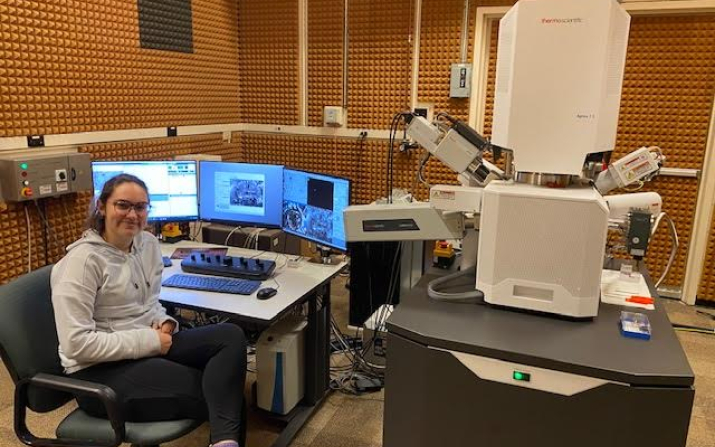SCSAM Fellow Spotlight: Claire Parker

In high school, Claire Parker took a materials science class, where she learned about blowing glass and melting sulfur. That class speared her interests in engineering and geology, and now, as a senior in Case Western Reserve University's Department of Earth, Environmental and Planetary Sciences, she is getting a chance to dive into her interests as a SCSAM Fellow.
Pointing out that the lower crust of the Earth has a lot of unknown due to its lack of accessibility and the Earth constantly changing, Parker hopes to "create a picture of the composition of the lower crust under Antarctica." Using the Apreo scanning electron microscope, she aspires to identify the minerals and their elemental makeup in xenoliths in volcanic rocks from eruptions in the West Atlantic Rift Zone. In previous research, Parker has found that the xenoliths are samples of the lower crust that have been transported rapidly to the Earth's surface by lava.
So far, Parker has created twenty thin sections (thin slices of rock that are micrometers thick mounted on a glass slide that can be used in a polarized petrographic microscope to see individual mineral grains) containing various xenoliths. As her research continues, there have been some surprises: she thought that some of the xenoliths contained garnet, but there was no garnet to be found once she began examining. Additionally, she has found a significant amount of single-mineral inclusions that she believes to be amphiboles.
"The rock saw in my lab needed a little more love and attention than we expected, so it took a little bit of time to get it running properly,” said Parker. “Once we had the rock saw running, I expected to see swaths of xenoliths with every slice of rock, but I was very wrong. Out of the 20ish rocks I cut, I found 30-40 usable samples. That seems like a lot, but the hours I spent cutting those rocks say differently.”
SCSAM Executive Director Jeffrey Pigott, who has been working with Parker, praised her for having a “great understanding” of her samples and for doing “an excellent job of quickly and thoughtfully interpreting the EDS data as it comes in to better guide her data acquisition.”
Parker is not a stranger to SCSAM, having used the Apreo for imaging samples of an unknown mineral in her mineralogy class, where the class's final project involved identifying the aforementioned mineral by its physical and chemical properties. In addition to the Apreo, the class also used SCSAM's x-ray diffractometers to determine the minerals' crystal structures.
In addition to her work in SCSAM, Parker has had the opportunity to do materials research around the country throughout her time at CWRU. During the Spring 2022 semester, she traveled to the Adirondacks in upstate New York to create a timeline of the region's geologic history, and took a spring break trip to Death Valley National Park to map the Northern Nopah Range. During the 2022-23 academic year, she will be traveling to Scripps Institute of Oceanography in San Diego, Calif., where she will use laser ablation inductively coupled-plasma mass spectrometry to quantitatively measure the trace elements of her samples.
In the future, Parker hopes to continue doing research in environmental geology, and her fellowship has been a strong stepping stone for that. “Learning about the instruments in SCSAM is super interesting and there are so many different uses for them in geology,” said Parker. “If we could grind up every rock and look at each individual chemical element, it would give us a lot of information.”
